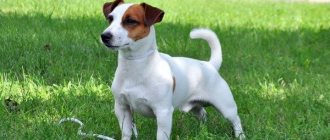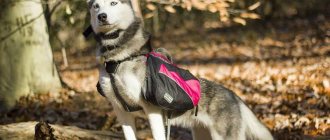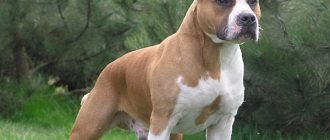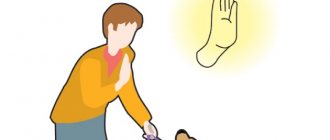Teaching your pet commands is a component of the educational process. Training is needed to instill discipline skills in your four-legged friend. A well-mannered dog is the pride and safety of its owner. With a disciplined pet, you will be protected from possible problems during walks, from disorder in the house, chewed slippers, unexpected barking, frightened passers-by and other troubles. Therefore, you need to teach your puppy commands as soon as possible - dog experts recommend starting classes at three months of age.
Traditional training methods
The success of dog training directly depends on the chosen method. Old school training is based on a system of positive and negative reinforcement, in other words, carrots and sticks.
Training instructions are full of recommendations to use force when the dog does something wrong: “press on the withers,” “pull the leash,” “pull the collar,” etc.
This is how it is advised to teach a puppy the command to Lie down in the traditional way.
Proponents of the old methods do not believe in the dog's ability to understand commands without coercive measures. The main objectives of such training are to suppress the animal’s nature, completely subjugate it, and achieve impeccable automatic execution of commands.
This approach to home training disrupts the contact between the animal and the owner. The dog associates negative emotions with the owner. He perceives him as the center of his troubles, from which he needs to stay away.
Excess negative emotions in sensitive dogs leads to stress. Chronic internal tension is considered the main cause of behavioral problems.
Why teach
The “Voice” command is part of the mandatory commands for the dog. It is included in the basic standard of any service dog. With the help of barking, he can scare away an uninvited guest, give a signal, protect the house, or show his attitude towards a stranger.
But if you approach training incorrectly, your dog can develop the habit of barking for no particular reason. He will vote solely for the sake of encouragement. In this case, it will be problematic to wean the dog from this method of communication, so training should be carried out taking into account strict rules. It is best to use techniques that have been proven by time and the experience of thousands of dog breeders.
Dog training using positive reinforcement
Over the past two decades, trainers and owners have been moving away from traditional home dog training methods.
The positive reinforcement technique relies entirely on the animal’s internal motivation to carry out the owner’s command and denies violent methods.
Dogs are social animals. Nature has endowed them with cognitive abilities aimed at building relationships with humans. In other words, they do not want to conflict with the owner who provides shelter, food, care and love. Dogs are also interested in building peaceful relationships.
The owner can only develop natural abilities and clearly explain what kind of behavior he expects:
- Positive reinforcement is everything that a dog loves and the simplest, most understandable way to convey information: do as I want, and you will get what you love. The animal quickly connects its behavior with a valuable reward. Next time he will complete the task more likely, faster and better.
- Positive reinforcement training takes place against a joyful emotional background and strengthens contact with the owner.
- The dog is sincerely interested in the result. He perceives the first award as an accident, the second as a coincidence, and the third as a pattern. After regular training, she shows initiative in anticipation of a reward, and herself offers the behavior desired by the owner.
- Positive reinforcement training is suitable for animals of any age: from a two-month-old puppy to an adult dog with behavior problems.
When being with the owner is emotionally comfortable, interesting, fun and tasty, basic skills are mastered “by themselves”, without effort.
Positive reinforcement does not mean permissiveness when the owner does not react to the pet’s actions. On the contrary, this is a humane way to set your own rules and teach your dog proper behavior.
Three pillars of home dog training – 3 types of motivation
A dog lives by its own laws, follows its instincts, and does not work for no reason. The driving force behind training is the animal's motivation. If a dog wants to get something, he is ready to strain, think and do.
The most effective 3 types of motivation:
- Food. A healthy dog is always interested in food. This property is due to the survival instinct. The owner encourages him to perform the desired action with a tasty piece and rewards him after correct execution.
- Gaming. Every dog has a hunting instinct. Hence the habit of tugging at objects and catching up. A favorite toy will work just as well as a tasty morsel to guide the animal to the desired action. Playing with the owner will encourage correct behavior.
- Social. This is secondary motivation, which is developed gradually. If you emotionally praise and stroke the dog with a treat or a toy, it will quickly understand the meaning of words and touches. Gradually, praise becomes an independent motivator without the addition of food and play.
It is easiest to control an animal that has developed all 3 types of motivation. A treat, a favorite toy, praise - this is the dog’s salary, for which he is ready to work.
Friendliness or bad manners?
Do you think your dog is very kind and simply adores everyone he meets? We have to disappoint you: this is not universal love, but a banal lack of upbringing.
If a well-mannered dog wants to say hello to someone, it does not fly headlong towards a stranger, does not jump around him, does not put his dirty paws on him and does not dirty his clothes from supposedly great love. No one will like such a display of feelings, and some may even be frightened.
Friendliness is very good, but you need to be able to show it. First you need to ask the person if you can approach him.
If a dog is raised correctly, it will approach a stranger only after your permission.
She will show him her joy and warm feelings: she will wag her tail and let herself be stroked. My Basta knows how to smile and makes her face so sweet that no one has ever been able to resist her charm.
Why Negative Reinforcement Doesn't Work
Negative reinforcement is any negative impact immediately at the moment of non-compliance with a command. Raising your voice and using forceful methods give temporary results; they have to be constantly tightened.
First, the dog reacts to shouts and obeys. Then he gets used to it and stops noticing. The owner increases negative reinforcement, using jerks on the leash.
This helps temporarily, but the animal adapts to them. You have to pull harder and so on ad infinitum. Particularly “advanced” trainers, out of their own powerlessness, end up with strict or electric shock collars.
Negative reinforcement does not teach anything and does not motivate you to take the right action. During training, the dog feels nothing but fear and disgust towards commands. As a result, he lives in a state of chronic stress.
Sensitive animals develop real neurosis, which is difficult to treat. You can forget about trust, respect and love. Fear becomes the main driver of actions.
Training with adults
It is more difficult to train an adult student. There are 3 reasons for this:
- Presence of established behavioral habits and character.
- Puberty - the work of hormones prevents the dog from responding promptly and correctly to the owner’s orders.
- It is difficult to “swing” an adult, to teach him to behave in a new way.
Despite various difficulties, the training is a success. But at the same time, it is necessary to conduct classes consistently, treat the student carefully and patiently.
Prepare to devote time from 3 months to a year to basic training. Think over your training methods, focusing on the character of your adult four-legged friend.
Avoid negativity when communicating with the student, as well as sudden movements (especially if the dog has attacks of aggression). Talk to him constantly.
Earn your pet's trust. This will help both of you complete the necessary training faster. Be sure to bring your favorite treats to every workout. Change the training area so that the dog is interested in learning something new.
There are special electric collars that ensure the student's obedience. But this is inhumane. This method can only be used by professionals when the animal poses a danger to others.
Sound markers of positive reinforcement
A beep is a way to instantly indicate the correct execution of a command. To do this, they use a clicker during training.
When you press the button, the clicker makes a clear click of medium volume.
Before the first lessons, train your pet in a calm home environment:
- Click the clicker. Then immediately give him a tasty piece.
- Repeat the exercise 5 – 7 times in a row, take a break.
- During the day, return to it 5–6 more times.
- Practice for 2 – 3 days, then check. Give the signal and watch the animal's reaction. If the dog perks up and looks expectantly, it means he understands the sound correctly and classes can begin.
The clicker is convenient to use, but it has disadvantages. The device takes up your hands, gets lost, and is forgotten. Some dogs find clicking unnerving. In initial lessons, you can use the word “Yes” instead of a clicker. It is said briefly, without emotion, always the same way.
A sound signal is given exactly at the moment of correct execution. He does not cancel the awards. After clicking the clicker or "Yes" marker, the dog is always given a treat, praise, or play. Without encouragement, the signal becomes useless.
Sound markers are convenient for recording short successful moments. You won’t have time to put a tasty piece into your mouth in a moment. The click of the clicker or the word “Yes” tells the animal: you did the right thing, now there will be a reward.
The signal instantly reinforces the execution of a command at a distance when it is impossible to immediately reward the dog. After mastering the skill, sound markers are no longer needed.
At what age should you start training a puppy and how long should you train?
Previously, dog training began at 6 months. During the training, forceful techniques were used that are not acceptable for small puppies.
You can start training with positive reinforcement at home as early as 2 months, and after scheduled vaccinations you can go outside:
- Conduct classes in short sessions, but several times a day, for example, in the morning and evening.
- The total time of one training session for a puppy is no more than 15 minutes, for an adult dog - 40 minutes.
- Repeat one command no more than 3-5 times in a row, then take a break, play with your pet or move on to another task.
- Finish the workout a little before he gets tired or loses interest.
Useful tips and recommendations from experts
For inexperienced dog breeders planning to start training a pet, we recommend learning useful tips and tricks from experienced dog handlers.
Dog Training Tips:
1. Commands must be pronounced loudly, briefly, with confident intonation.
2. You can’t be too strict when dealing with an animal. Have patience and control your emotions. You cannot beat or cruelly punish a dog for disobedience. 3. Each technique should be repeated at each lesson, practicing the acquired skill. 4. The training system is built from simple to complex. The load and time of training gradually increases. 5. For obedience and following new commands, the dog should be rewarded with a tasty treat, but in moderation. 6. Maintain consistency and stick to the same tactics. If you introduce any prohibitions, always follow them, otherwise the dog will stop obeying you. Basic rules in compliance with the educational process techniques will allow you to train a domestic dog of any breed and age. Be patient and be prepared to spend a lot of time and effort on the training process, but these efforts will not be in vain!
What treat to give a puppy during training?
A tasty piece for training as a pointer. It guides you to the desired action, helps explain the command, and marks successful completion.
The dog is not fed before training, otherwise the pet will not be interested in the treat. A hungry dog is also a bad student. The smell of food will become a strong irritant, distracting attention from the owner.
Feed your pet 2 – 3 hours before training.
Everyday food will not be an effective stimulus. For classes, take the most desirable food that meets the criteria:
- Will not harm the dog's health.
- Doesn't get your hands dirty. For example, raw meat is attractive to animals, but leaves marks on palms and clothes.
- Affordable: food for training is needed constantly, not on holidays.
- Doesn't crumble. The boiled chicken flakes in your hands, falls to the ground, and distracts the dog.
The size of the pieces is made so that the dog can quickly swallow. If he chews the earned treat for a long time, he forgets why he received it. But don’t deceive your pet, don’t give him crumbs that he won’t feel at all.
Here is a treat option that is suitable for training:
- Take beef lung, heart, and liver in equal parts.
- Wash and boil for 30 - 40 minutes.
- Cool, cut into cubes.
Dogs love this food, it is not harmful to health, does not leave marks on the hands and does not fall into pieces.
Other types of training food:
- Boiled stomachs, chicken hearts, cut into cubes.
- Slices of low-fat sausage or cheese are not healthy food, but they will do when you have nothing on hand.
- Ready-made treats for training from a pet store.
Training pads for dogs of any age and breed.
Before starting classes, practice at home how to catch a dog with a piece, teach it to follow your hand. Bring your fingertips to your nose, let him sniff, and move the side away so that the puppy follows the piece.
Teaching Methodology
Many people think that you can’t raise or train an adult dog. They are confident that they can be trained only from puppyhood. This is not true.
Yes, kids learn various commands faster, so it’s easier to conduct classes with them. But an adult four-legged friend can also be trained. The main approach is regular training, proper handling, and great patience. You should not feel nervous if the dog does not immediately understand what the owner requires of him.
Where to train
The most favorable place for studying is an area that is well known to the student. It is advisable to exclude distracting circumstances: moving vehicles, active passers-by, other animals. If you happen to conduct training in an unfamiliar area, then you need to let your pet go for a walk and explore the territory. This will calm him down, and he will calmly return to his studies. When the dog gets used to one place, you can move to another area.
When to train
You can train at any time, subject to certain restrictions. You should not train a four-legged animal:
- immediately after he wakes up;
- in the heat - this can cause overheating, dehydration, and other unpleasant events;
- immediately after eating.
If you cannot avoid exercising during the hottest part of the day, take an adequate supply of drinking water.
What to take to training for encouragement
Reward your student with treats that he likes. This could be dry cookies or special food, cheese, meat, or other products.
In addition to treats, you can give your dog the right kind of praise. What does this mean? You need to encourage it right away. If the puppy has already completed the task a long time ago, and you just decided to praise him, then he will not understand it as it should.
Auxiliary items
For each training session it is necessary to take special items to facilitate the learning process.
- Trainer's bag for treats.
- Leashes - short (1 to 1.5 m long) and long (10 to 12 m long).
- Muzzle.
- Collars - regular and strict (made of metal). The latter is needed when the dog does not react to standard painful stimuli.
- Grip, or “rope”. This is a conditional opponent whom the student bites.
- Ringovka, aka noose. Used by applying physical force to adult quadrupeds. Models with a lock are attached to the desired location of the neck.
- Dumbbell - plays the role of prey. The student brings it with the order “Fetch!”, gives it to the owner with the command “Give!” You can't just play with her like that.
Take toys - a puller, an Arabian ball, a rope. They will help diversify the training process and facilitate learning.
Recommendations for self-study
Training dogs on your own requires compliance with the following recommendations.
- Regularity of classes. Or better yet, daily.
- Gradually increase the duration of classes. You can start with 15 minutes.
- Clear orders. Commands and rewards should be given different intonations so that the dog can distinguish them.
- Repeat the requirement no more than 2 times. Otherwise, the dog begins to understand that he doesn’t have to carry out the order the first time, but drags out time as long as he likes.
- Attracting the attention of your four-legged friend. To do this, use the animal's name, pronounced loudly and clearly.
- Constantly rewarding your pet for success. Use treats or praise, you can alternate.
Always maintain your composure if a student fails to complete assignments. If you raise your voice, your four-legged friend will also become nervous and quickly stop trusting you.
It is strictly forbidden to hit a dog.
Where to start training a puppy
The first condition for successful training is to establish eye contact with your pet.
The basis of house training: eye contact with your pet.
This word hides not just mutual understanding, trust and the joy of communication. This is the ability to look, hold your gaze, concentrate attention on the owner, without being distracted by external stimuli.
The dog thinks about what he sees in front of him. When she looks at her owner, she hears him and is ready to receive and carry out commands.
Therefore, first teach your pet to quickly switch his attention to you:
- At home, sit opposite the puppy, show a piece and hide it behind your back.
- When he starts looking, call him by name.
- Wait until the dog looks into your eyes, catch your gaze at least for a second.
- At this point, give a sound signal with a clicker or the word “Yes,” praise and give the piece.
- Repeat the exercise in a calm environment at home 3 to 5 times in several sessions with breaks.
- Then continue training while walking: first in a vacant lot, then in an area with irritants.
- Gradually increase your concentration time - hold your gaze for 2, 3, 5 seconds. And only then give a sound signal, praise and treat.
Gradually, the puppy will understand that looking at you is beneficial, because they give you a treat for it. He will stop running away during walks and will start looking around more often. This behavior can easily be overridden by other commands.
Necessary equipment
For independent training with your pet, you will definitely need a collar and leash for control and manipulation, a stick or toy for fetching, as well as a pre-prepared treat. These simple things may be enough to help your dog follow basic commands.
If you plan to prepare your dog for more serious exercises, such as obstacle racing, wall climbing, descent and ascent, you need to arrange the area in advance, prepare barriers and other devices. You should read the necessary literature in advance and choose the right equipment depending on the age, height and weight, breed and physical abilities of your dog. It is best to start this kind of training at a dog training school, and then continue at home, following the example.
What commands can you learn with a dog?
You can independently master basic skills that will greatly simplify your life together with your pet:
- Run up to me instantly when called.
- Sit, Stand, Lye down - take static positions and not move from your place without permission.
- Nearby - do not pull the owner on walks or move without a leash.
- - calmly walk past discarded food on the street, do not pick up garbage from the ground.
- Place - go to the bed upon request.
- Give - calmly give away a grabbed bone or valuable thing.
- Bring - this skill will come in handy during the game, when you need to release accumulated energy.
To assess progress, mastering a new skill can be divided into 4 main stages:
- First successful execution.
- A dog demonstrates a new skill without hesitation 8 times out of 10 in a quiet, secluded place.
- The command is executed without delay anywhere on the street or at home, with various distractions.
- The new skill becomes part of everyday life, you just have to maintain it.
For major success and transition to the next stage of training, the dog is rewarded with a large portion of the most desired treat. This is like a “jackpot” that is awarded in case of a significant breakthrough.
Briefly about the main thing
- Dogs are well trained in various commands and tricks. It is advisable to carry out training from puppyhood.
- For classes you will need a short leash, treats and toys.
- The main normative commands are place, fu (quiet), come to me, sit, lie down and next to me. They need to be mastered first.
- After teaching basic words, you can begin training complex tricks, for example, teaching your pet to do a somersault or stand up like a gopher.
What commands does your dog know? Share in the comments how you trained your pet.
The dog does not follow commands - what to do?
Failures in training often occur for three reasons: low motivation, owner mistakes, poor health of the animal:
- Don't rush the dog. She will set the pace herself, because everyone’s learning speed is different. Some people learn a new skill after 5 repetitions; for others, even 100 repetitions are not enough. But even the most brilliant people will not complete a task for the first time in an unfamiliar environment, with strong stimuli. Read on the topic: The most trainable small dogs in S. Koren's ranking.
- Set achievable tasks. Complicate the tasks gradually: the more distracting objects, the more difficult it is for the dog. Train first at home, then outside in secluded corners, then in places with a minimum of irritants. When the puppy begins to succeed, move to areas with strong distractions, where other animals and strangers walk.
If training is moved from the house directly to a noisy yard, the pet will forget all the commands.
- Change your position relative to the dog. Give command while standing opposite, to the side, behind, move 3 to 5 steps to the side. The animal develops a behavioral stereotype; it is difficult for him to complete a task heard from an unusual place the first time.
- Review learned skills periodically. The dog may simply forget them.
- Exercise only in a good mood. If something bothers you or irritates you, postpone your workout. Negative emotions are transmitted to the animal and interfere with learning.
- Set the strongest motivation possible. Experiment with what is more important to your puppy: a toy, a tasty bite, or your approval. In the initial stages, food and play come first. Praise and petting work less well. Sometimes it is enough to change the treat and the result will immediately appear.
- Reward every small success until the new skill is fully mastered. When the animal learns to carry out the command with any distractions, reduce the reward with food, but do not refuse it at all.
- Praise from the heart.
- Monitor your pet's well-being. Sometimes a dog refuses to follow commands if something hurts.
The dog does, without coercion, only what is beneficial to it. Let her understand that correct behavior and following commands are tasty, pleasant and fun. Success will come when your interests coincide with those of your pet.
How to teach a dog the “Come to me” command at home
This is the most important command. It will protect the animal from dangers and the owner from conflicts during a walk. Puppies untrained in the skill of calling are not allowed off the leash on the street.
Completing the task lasts seconds, but the dog will have to be taught three elements:
- Instantly be distracted from your activities and turn your attention to the owner.
- Run up quickly without being distracted by foreign objects.
- After completion, sit at the left leg or opposite, look at the owner, wait for instructions.
In order for your dog to master the exercise 100%, train it first at home, then on the street with various distractions.
How to teach a puppy to call - first steps
First, the puppy is introduced to the “Come to me” command at home:
- The first step is to explain the meaning of the command, form a connection between the words and the movement towards the owner. Call your puppy when he looks, is ready to run, or is heading in your direction.
- Say the command calmly and clearly so that it does not get lost in the flow of words, with positive intonations. When the puppy runs up, confirm success with a sound signal, treat him with a treat, and praise him.
- Second stage - move away 1 - 2 steps. Catch the moment when the puppy looks in your direction, show a toy or food and command “Come to me.”
- The third step is to call the puppy when he is not looking at you, but is not doing anything interesting. When he runs up, take a couple of steps back so that the puppy follows you.
- The fourth step is to give the command when the puppy is captivated by the toy. If he doesn’t react, it means it’s too early to complicate the task. Go back temporarily.
- Fifth step - call the puppy from the next room. Don’t forget to treat and praise every time.
- The final element is to teach him to sit at your feet. Bring the piece to your nose, lift it above the puppy’s head, and move it slightly back to the eye line. When he lifts his muzzle, his hind end involuntarily falls to the floor, that’s how dogs are designed.
The main mistakes in initial training in calling:
- Repeat the command several times. The puppy will get used to running up within 2–5 attempts. The main task for a novice trainer is to learn to recognize when the pet is likely to approach.
- Call in a menacing voice.
- Say your nickname and command together. They should not merge into one word. A name is needed to attract attention, a command is needed to call.
- Calling the puppy for unpleasant hygiene procedures or to scold him for misbehavior.
Associate only positive emotions with your team.
How to teach a dog to look at its owner more often while walking
Outside the house, a new world of sounds, smells, unfamiliar people, dogs and cats opens up for the puppy. Under the influence of impressions, he forgets about the owner and stops noticing.
In such conditions, training is useless. First, make eye contact with your pet on the street, teach him to see and hear you. Find a quiet place with a minimum of irritants or take him out into the yard early in the morning or late in the evening.
To train your puppy's attention, it is useful to perform 3 exercises:
- While walking, stop silently and wait for the dog to look at you. Keep a short leash of no more than a meter. Let the dog run around and sniff around. When he looks at you or approaches you, give a sound signal and reward him.
- After 3 – 5 repetitions, let him run on a long leash. Do 5 of these exercises on every walk.
- Regulate your dog's attention while moving. Walk at a calm pace, then stop. As soon as the dog turns to you, take out a tasty piece and take two steps back. Let him come and take it himself. Soon the dog will turn around during stops.
- Show the treat and turn away. The dog will run in front and begin to look for interaction with you.
At this stage, do not call the dog or pull the leash. The purpose of the exercises is to achieve attention without coercion. If the dog comes up and doesn’t want to leave, play with him. Show how fun and interesting it is to be with you. Then let him run on a long leash.
Become interesting to your pet, and he will not want to walk on his own and run after dogs.
Command “Come to me” on the street
After making eye contact, return to practicing the call. Walking is too much for your puppy to experience, so start the activity close at hand in a quiet place:
- Keep your puppy on a 2-3 meter leash. Show him a toy or treat and call him when he is not interested in anything and looks in your direction. Associate the correct execution of a command with positive emotions. Praise, treat him with tasty snacks, play and let him go for a walk.
- Gradually increase the length of the leash, first to 5, then 7, 10 meters. Call as before when the dog turns to you and is ready to come running. Give commands in a lively, joyful voice.
- Repeat the call every 10 to 15 minutes while walking, give him treats, praise, and send him running again on a long leash. Help the puppy not to be distracted by foreign objects along the way. Run back yourself, encourage them with clapping and praise.
- Then for 5 simple calls add 1 complex one. Give a command when the dog is distracted and not looking at you. Learn to determine how absorbed she is. Call when you are sure of execution. If the dog does not come running when called at the moment of sniffing a beetle in the grass, then he will not be able to switch his attention in the midst of the game.
- Without a leash, a dog behaves differently and often stops obeying. When practicing the “Come to me” command, tie a 10-20 meter long rope instead of a leash. It will give you a feeling of freedom. However, you can step on the tip at any time and control your pet from a distance.
- At the final stage, show what to do after the command is executed. As it approaches, catch your pet with a piece and lead it to the desired place. Then raise the treat above your puppy's head and he will automatically sit at your feet.
When the calling is 100% successful in secluded places, move to areas with external stimuli. Again, start close.
The pet is released from the leash when it immediately runs when called, even if a cat appears nearby or other dogs are playing.
The dog does not come when called - correcting mistakes
According to the rules, the call is given only once, and the dog must come running at the first request. However, the ideal model is not always obtained. Blaming an animal is not productive, try to understand your mistakes.
Here are possible situations that lead to pet disobedience:
- You call the dog in a threatening tone. No sane creature will want to approach if he hears evil intonations. Give commands in a positive voice.
- The pet hesitated, got distracted, and ran up late. You scold for this. The dog lives in the present. She does not connect the owner’s dissatisfaction with the action committed minutes earlier. The pet’s mind combines the disapproval of its beloved owner and the moment of approach. Next time he won't want to run up. Praise and reward even for completing things late.
- The dog doesn't listen, you're trying to catch it. The dog perceives such actions as a game. It’s a pleasure to join in. Try to run away. The dog will instinctively follow. At this moment, turn around, command “Come to me,” and reward after execution.
- On the street you let the dog run freely and play. At the end, you call, buckle up, and take you home. If walks follow this scenario, the joy and fun ends for the dog after following the order “Come to me.” Call your pet 5-10 times per walk. Praise him and send him running again. To smooth out the moment of returning home, play a little along the way.
Sometimes owners behave unpredictably. During training, commands are consistently taught using positive reinforcement. At home they scream and beat you for wrongdoing. As a result, the dog is afraid to approach. He simply doesn't know what to expect from the owner.
If you have difficulty training your dog on his own, you can sign up for training courses. Each dog handler has his own experience and valuable findings. Even on free webinars you can find a lot of useful information for yourself.
Common Mistakes
Not all dogs can be trained to follow the “Voice” command. Some breeds are simply not trainable, such as most hunting dogs. In addition, excessive pressure on the dog can negatively affect his psyche - cause aggression or even illness. If you are unable to train your dog on your own, it is recommended that you contact a professional.
During the training process, it is strictly contraindicated to punish or beat the dog. This can only spoil her character and make her very aggressive. All commands must be pronounced in a calm, even and clear voice, and no anger or dissatisfaction should be heard in the sound of the voice.
Whatever training option is used, we must not forget that a dog is a living, intelligent creature. The dog will happily follow any command if the owner treats him well and with respect.
Team Near – Homework
This is a difficult task. The dog needs to be able to start moving, accelerate, slow down, stop, and make turns. First, determine the pet’s place next to you - at your left, right leg, or is it allowed to walk on either side. Determine for yourself how far it can move. Usually the leash sags a little.
The more clearly you present the model of your pet’s future behavior, the more clearly you explain, and the puppy will understand faster.
Conduct the first lessons at home, dedicate to explaining the command. At the same time, introduce the puppy to the leash:
- Put the leash on so that it has a little slack. Stand near your pet and give him a tasty bite. This way you will designate a place near you. Do not enter a verbal command yet. It is perceived as noise and prevents the puppy from concentrating on the task.
- Take 1 - 2 steps forward. When the puppy follows you, praise and treat.
- Gradually increase “walks” around the house, constantly reinforce correct behavior with praise and treats.
- When the puppy begins to move freely at your foot, introduce the word Near. This is the only command that can be repeated more than once.
When the dog understands the meaning of the command, move on to walking exercises.
How to stop a dog from pulling on a leash outside
Before your walk, encourage your dog to walk next to you in the hallway. Don't let us run ahead. If she rushes through the door, stop at the exit. Approach your pet and move the leash to the side. Don't pull back, it will only encourage you to run forward. When the dog stands at your feet, praise him, command “Near” and walk.
To practice outside, find a quiet, deserted place. First, let the dog go to the toilet and run around. Play for 5 – 10 minutes. Active animals need to lose energy. Then start training:
- Take the puppy by the leash and lead him to the place next to you, which you have designated at home, for a treat. Give the command and start moving. Stop every 2-3 steps, praise, treat.
- If the dog runs forward and pulls on the leash, don’t pull, just stop. Then call your pet and take a couple of steps back. When he returns, do not give him a treat, do not reinforce the desire to run away, or pull on the leash. Just command and continue the exercise, encouraging occasionally.
- If the dog becomes interested in an object in the distance and rushes forward uncontrollably, approach while holding the leash. Then pull to the side without jerking and turn the animal in the opposite direction. Command “Nearby.” After 3–4 steps, praise, reward, and continue moving.
- Turn an overly energetic puppy around every time he rushes forward with force. Then move in the opposite direction. Do not pull the leash, this gives short-term results. On the next walk everything will repeat all over again.
Exercise regularly on each walk in several sessions. Walk on a short leash for 5 minutes. Then play, let him go for a walk for 5 - 10 minutes.
Friends, leave comments. Your additions and experience with dog training at home are helpful for new owners.











